Food and clothing have long had an intensely dysfunctional relationship. Both are subject to the vagaries of fashion, both are employed by the cognoscenti as indicators of style, intelligence and status: they have so much in common yet, in many people's minds, are mutually exclusive.
While food trends change as quickly as shoulder widths, fashionistas are rarely known for their hearty appetites, and foodies - with the notable exception of the divine Nigella - are hardly the most stylish people in the world. You can't chop fresh herbs and dismember a wild rabbit yet retain an immaculate manicure, just as you can't eat potted duck with picallilli and expect to squeeze into an Azzedine Alaia-structured shift.
Of course, the world of fashion is where so many of those food fads come from: apply as many parameters as possible to a canapé - carb-free, wheat-free, fat-free, sugar-free, organic, bite-sized, vegetarian, raw - and you have something that is not only insanely expensive and rare, but virtually inedible and therefore perfect fashionista fodder. Sashimi is not only popular among style setters because it tastes fantastic (though of course it does): it is also pure, unadulterated protein, uncooked, unprocessed and only to be attempted by master sushi chefs at the likes of Okku or Nobu if one is to avoid food poisoning. (Supermarket sushi? Stodgy and sugary, the food equivalent of high-street rip-offs and therefore beyond the pale.) At the Villa Moda launch in DIFC a couple of weeks back, the Zuma canapés were as big a hit as the Moncler jackets.
Nevertheless, extravagant, sweet, luxury foods hold a strange fascination for those to whom they are forbidden, from the methinks-she-doth-protest-too-much claims of catwalk models that they just love to scarf Big Macs between shows, to the style-setting French queen Marie-Antoinette's mythical predilection for cakes (even if the peasants had to make do with brioche). Dubai's obsession with cupcakes and Paris's long-term love affair with macaroons (are you a Ladurée traditionalist or a Pierre Hermé iconoclast?) are among the most enduring food fashions ("enduring", in fashion, meaning of course something that lasts more than one season).
Less enduring, however, were the neon-green-iced pastries provided last September on the Fashion Bus that transported editors between the shows at the spring/summer 2009 Paris Fashion Week. The Zoolander-esque eclairs and mille-feuilles were very of the moment - the last heady days before the recession hit - and therefore failed to make an appearance the following season when austerity was the buzzword.
The synergy between food and fashion is all too easy to deride, but that hasn't stopped some literal reinterpretations on both sides of the plate - though the underlying message is often one of compensation. Take London's Pret-a-Portea afternoon tea at The Berkeley Hotel. A long-time favourite at the hotel, the head pastry chef Mourad Khiat recreates the season's most popular pieces in delectable cake and icing: a pair of soaring Louboutins, for example, or a Chanel handbag. "Fashion and cakes have always been the perfect match for me," explains Khiat. "We have insider fashion contacts to brief us on the must-haves of the season. Of course, I do have my favourite designers but I could never reveal who. Mostly, I look for vibrant colours and unusual designs and textures and visualize how they'd translate onto our tea stand." All of which is to say that, from Dh200, you can devour insanely expensive waiting-list handbags almost as fast as Victoria Beckham collects Birkins.
At the other end of the spectrum, Boucheron recently launched their Tentation Macaron fine jewellery line, which uses macaroons as the inspirations for a series of jewel-encrusted pieces. On one piece, pink sapphires are employed to emulate the exterior of the delicate, candy-coloured delicacy, with rubies representing the chewy centre. One could munch an incalculable number of pink macaroons for the Dh32,000 that this ring costs, but sugar-phobic fashionistas will always prefer the inedible option, keeping temptation at a safe distance.
So whither food and fashion now? Well it looks as though they might be on different paths for a while: the back-to-basics menu at Sublime Canapés, which caters for many London Fashion Week parties, includes old-fashioned, filling delicacies such as fish pie, cockle and watercress tartlet, boeuf bourgignon and lemon meringue pie. And our hot fashion tip for next season? The return of the muumuu.





